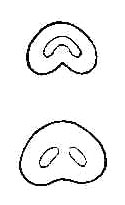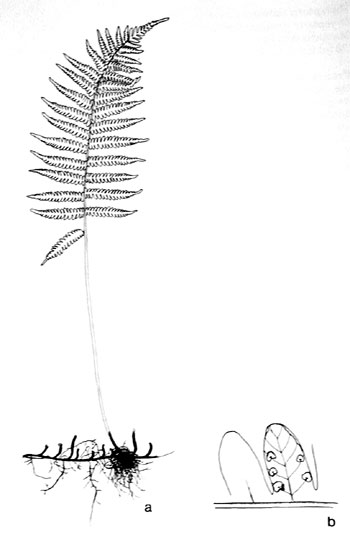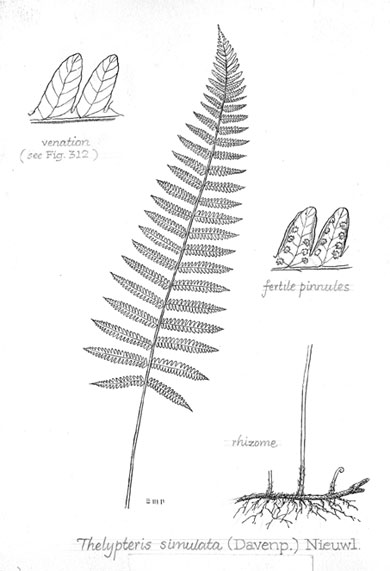|
Hardy Fern Home T. simulata resources
All Ferns � Thelypteridaceae �� Thelypteris
�Other Genera
|
| Thelypteris simulata | ||
Massachusetts fern,Bog fern | ||
|
Etymology
Simulata means resembling, in this case forms of the lady fern, Athyrium filix-femina, according to George Davenport.
Description
Rhizome: long-creeping, branching, some stipes distantly spaced, some closely spaced, ovate, pale brown scales, mostly at the apex.
Frond: 80 cm high by 15 cm wide, deciduous, monomorphic, though sterile fronds arching, fertile taller, more erect, with longer stipes, blade/stipe ratio: 1:1 to 2:1, fertile fronds having longer stipes. Stipe: brown at base, shading to green, sparsely set with tan, ovate, scales, vascular bundles: 2, oblong, at 90�, at stipe base, merging above to a u-shape. Blade: 1-pinnate-pinnatifid, lanceolate, widely separated pinnae, tapering to the tip, widest at or just above the lowest pinna, membranous, pale green, short, whitish hairs, falling soon, and yellow glands, also blade tissue with numerous reddish to orangish, resinous, shiny, sessile, hemispheric glands. Pinnae: 16 to 18 pair, lanceolate, long tapering, less incised near the ends, 2 cm wide, subopposite; pinnules 15 pairs �, blunt, fertile pinnules slightly inrolled, not strongly; costae grooved above, discontinuous with the rachis; margins entire; veins free, simple. Sori: round, midway between the margin than the costule, merging into each other, indusium: reniform, whitish, then tan, at a sinus, sporangia: brown. Dimensionality: lowest pair of pinnae bending down, forward. Culture
Habitat: moist, shady woods, cedar and sphagnum swamps.
Distribution: northeastern North America.
Hardy to -30�C, USDA Zone 4.
Distinctive Characteristics
The free veining (not forking) and the bending forward, down of the lowest pinna pair separates this from T. palustris. The sori are distinct here, the indusium present, neither true with T. palustris. Confusion with T. noveboracensisis precluded by the latter's tiny lowest pinnae.
Synonyms
Aspidium simulatum Davenport Parathelypteris simulata (Davenport) Holttum Dryopteris simulata Dav. Lastrea simulata Dav. Nephrodium simulatum Dav. ex Diels |
|
|
Notes
Compare to Dryopteris might be considered because of the reniform indusia, but the failure of continuity of the groove from rachis to costa, the 2 vascular bundles, and the presence of hairs all preclude that genus.
Compare to Dryopteris might be considered because of the reniform indusia, but the failure of continuity of the groove from rachis to costa, the 2 vascular bundles, and the presence of hairs all preclude that genus.

Thelypteris simulata. Two oval to elongate vascular bundles at the base of the stipe uniting above to an inverted v-shape above. �Drawing from Ferns of Northeastern United States, Farida A. Wiley, 1936. |

Thelypteris simulata. a) frond, lowest pinna bending down; b) fertile pinnule, veins mostly unforked, always meeting the margin above the base of the pinnule. �Illustration by V. Fulford from Ferns and Fern Allies of Canada, William J. Cody and Donald M. Britton, 1989, � Agriculture Canada, used with permission. |
